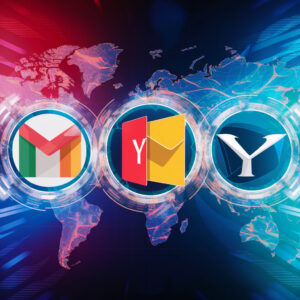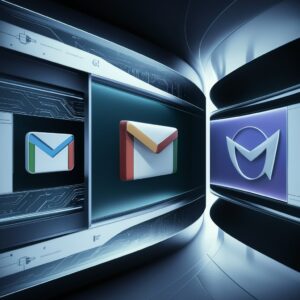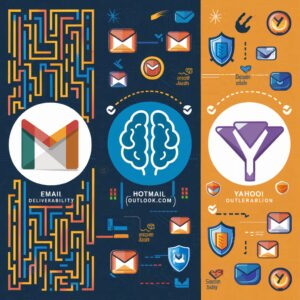Comparing Email Services: Gmail, Hotmail, Yahoo
Email services have become essential tools for communication in today's world, both for personal and professional purposes. Numerous email service providers have emerged as technology has advanced, each offering distinctive features and advantages. Gmail, Hotmail (formerly Outlook), and Yahoo Mail are widely recognised email platforms people use worldwide.
The services have revolutionised communication methods by offering diverse features to boost productivity and user satisfaction. Gmail, a product developed by Google, is widely recognised for its robust spam filtering, ample storage capacity, and seamless integration with other Google services. Outlook, formerly known as Hotmail, is Microsoft's email service that boasts a user-friendly design, providing a seamless experience for those familiar with Microsoft Office applications.
Yahoo Mail has been a reliable email service for a long time, featuring an easy-to-navigate interface and plenty of storage space. Different email platforms have unique ways of organising messages, setting storage limits, managing attachments, and creating user-friendly interfaces. In addition, a range of email deliverability rates directly affect how reliable messages are in reaching their intended recipients.
These services offer varying levels of security and privacy measures. The providers ensure the security of user information by implementing encryption methods, two-factor authentication alternatives, and data protection rules. Understanding the unique features, messaging capabilities, and security measures of Gmail, Outlook, and Yahoo Mail can help users decide which email service best meets their needs.
Features of Gmail
Robust Search Functionality and Ample Storage Capacity
Gmail's highly efficient search functionality enables users to locate specific emails using keywords or filters effortlessly. In addition, Gmail provides users with ample storage capacity to store numerous emails and attachments.
Seamless integration with various Google services and robust security measures
Gmail seamlessly integrates with various Google services, including Google Drive, Google Calendar, and Google Docs, allowing users to effortlessly access and collaborate on files and manage their schedules without leaving their email accounts. In addition, Gmail offers strong spam filtering and security measures to safeguard users against phishing attacks and malware.
Enhanced Customisation and Organisation Features
Gmail allows users to organise their emails into various tabs, including Primary, Social, Promotions, and Updates. This feature simplifies the task of prioritising and managing emails for users. In addition, Gmail allows users to personalise email signatures, establish automatic responses, and organise incoming emails using filters. Gmail offers a wide range of features that meet the requirements of both individual users and businesses.
 Features of Hotmail
Features of Hotmail
Outlook.com, formerly Hotmail, is a top-rated email service offering users many features. The interface is designed to be user-friendly, with a streamlined layout and easy navigation similar to Gmail. Hotmail stands out for its seamless integration with Microsoft Office Online, allowing users to effortlessly create and edit Word documents, Excel spreadsheets, and PowerPoint presentations directly within their email accounts.
Hotmail's seamless integration with productivity tools makes it a valuable option for individuals who rely on Microsoft Office for their professional or personal needs. The platform prioritises user security with solid measures such as two-factor authentication and thorough spam filtering, ensuring protection against unwanted emails and potential security threats. Furthermore, Hotmail allows customers to create aliases for their email addresses, allowing them to have separate email identities for different purposes.
This feature can be particularly beneficial for organising personal and professional correspondence or managing subscriptions and newsletters. Furthermore, Hotmail offers a focused inbox feature that organises essential emails into a separate tab, making it easier for users to manage their correspondence efficiently.
Features of Yahoo
Yahoo Mail is a highly regarded and extensively utilised email service that has consistently remained popular in the market for a considerable duration. The software's user interface is designed to be intuitive and user-friendly, allowing for easy customisation with a range of themes and layouts. This allows users to personalise their email experience to their liking. Yahoo Mail stands out for its seamless integration with Yahoo News and Yahoo Finance, allowing users to stay updated on news and financial information from their email accounts effortlessly.
Yahoo Mail's integration enables customers to effortlessly stay informed about current events and market trends, eliminating the need to switch to another platform. Furthermore, Yahoo Mail offers a range of security measures, such as SSL encryption and spam screening, to ensure the safety of its users. In addition, customers can create temporary email addresses, which helps protect their privacy when signing up for online services or subscriptions.
Furthermore, Yahoo Mail offers a powerful search feature that allows users to find specific emails using keywords or filters easily. Users can also customise their inbox layout, set up filters to organise incoming emails, and create automatic vacation responses. Yahoo Mail offers a wide range of services that cater to the needs of both individual users and businesses.
 Comparison of Deliverability
Comparison of Deliverability
Regarding deliverability, Gmail, Hotmail, and Yahoo have established themselves as reliable and consistent in delivering emails to recipients' inboxes. However, every provider handles the issue of deliverability in their way. Gmail is widely recognised for its highly effective spam filtering algorithms and impressive delivery rates.
The system utilises cutting-edge technology to accurately detect and remove spam, ensuring that legitimate emails are successfully delivered to recipients' inboxes without being mistakenly marked as spam. Outlook.com, previously known as Hotmail, has implemented strong spam filtering measures to protect customers from receiving unwanted emails. The system utilises advanced machine learning algorithms to analyse incoming emails and identify any potential instances of spam or phishing.
In addition, Hotmail has gained a reputation for its reliable and consistent delivery of emails to recipients' inboxes, making it a trusted choice for personal and corporate communication. Yahoo Mail prioritises the successful delivery of emails by implementing strong measures to filter out spam and enforcing stringent security policies. The system utilises domain authentication mechanisms to verify incoming emails and prevent spoofing or phishing attacks.
Gmail, Hotmail (Outlook.com), and Yahoo Mail are dedicated to guaranteeing the successful delivery of emails. They all have robust measures to protect customers from spam and security risks. Nevertheless, Gmail's spam filtering algorithms and high deliverability rates set it apart.
Security and Privacy
Enhanced Security Features
Gmail prioritises security by offering advanced features like two-factor authentication. This additional layer of protection requires users to verify their identity using a second factor, such as a mobile device or biometric data. In addition, Gmail employs encryption protocols to safeguard emails during transmission and storage, guaranteeing the security of sensitive information and preventing unauthorised access.
Ensuring the security of users' accounts and communication
Hotmail (Outlook.com) places a strong emphasis on security, providing users with two-factor authentication and encryption protocols to ensure the protection of their accounts and communication. The system uses advanced machine learning algorithms to identify possible security risks, like phishing attacks or unusual login behaviour, giving users an extra layer of security and assurance.
Protecting Your Privacy
Yahoo Mail has implemented robust security measures, including SSL encryption and two-factor authentication, to safeguard users' accounts from unauthorised access. The platform provides disposable email addresses and employs domain authentication techniques to bolster privacy and protect against spoofing or phishing attacks. All three email services have robust privacy policies to safeguard user's personal information and data, ensuring high privacy. The company follows industry standards for data protection and privacy regulations, ensuring that users' information is handled responsibly and with transparency.
 Summing Up
Summing Up
Gmail, Hotmail (Outlook.com), and Yahoo Mail are all highly regarded email services that have been thoughtfully designed to prioritise the user experience. Every service provides a wide range of capabilities to cater to the diverse needs of both individual users and corporations. Gmail, for example, is known for its powerful search capabilities, large storage capacity, seamless integration with other Google services, and practical spam filtering algorithms that improve the user experience. By grasping these user-centric features, consumers can make a more informed decision when choosing an email provider.
It is popular for individuals who appreciate efficient organisation and productivity features. Hotmail, also known as Outlook.com, is well-regarded for its seamless integration with Microsoft Office Online, robust security features such as two-factor authentication, and a focused inbox function. It is a convenient choice for users who rely on Microsoft Office for their professional or personal needs.
Yahoo Mail, for example, allows users to personalise their email experience with customisable themes and layouts. It seamlessly integrates with Yahoo News and Yahoo Finance, providing convenient access to news updates and financial information. Yahoo Mail prioritises user data security with robust measures like SSL encryption and disposable email addresses. The focus on security should reassure users and instil confidence in their decision to use this email service. Ultimately, the decision of which email service to use, whether Gmail, Hotmail (Outlook.com) or Yahoo Mail, depends on individual preferences and specific requirements.
All three email services prioritise deliverability, security, and privacy to ensure users' reliable and secure communication experience.
FAQs
Can you please provide information about gmail.com, hotmail.com, and yahoo.com?
Gmail.com, hotmail.com, and yahoo.com are widely used email service providers that offer free email accounts. Users can use these accounts to send and receive emails and access additional features like calendars, contacts, and file storage.
What is the process for setting up an email account with popular providers like Gmail, Hotmail, or Yahoo?
To set up an email account with any provider, visit their websites and follow the sign-up process. Personal information, including your name, desired email address, and password, is required.
Could you please provide information on the features offered by gmail.com, hotmail.com, and yahoo.com?
These email service providers provide a range of valuable features, including spam filtering, email organisation, integration with calendars and contacts, and the ability to access emails from multiple devices.
Are gmail.com, hotmail.com, and yahoo.com free to use?
All three email service providers offer free email accounts with essential features and premium plans with extra features for a fee.
Can I access gmail.com, hotmail.com, and yahoo.com from my mobile device?
Indeed, all three email service providers provide mobile apps for iOS and Android devices, enabling users to conveniently access their emails and other features while on the move.
References
- Email Essentials: A Beginner's Guide (2023) by TechSmith (https://support.techsmith.com/hc/en-us/articles/16903203290637-Change-My-TechSmith-Email-Address)
- A Guide to Email Security (2024) by National Cyber Security Alliance (https://staysafeonline.org/)
- How to Choose a Secure Email Service (2023) by Electronic Frontier Foundation (https://www.eff.org/deeplinks/2018/05/pretty-good-procedures-protecting-your-email)
The Post Taking a Look at Gmail, Hotmail, and Yahoo! appeared first on https://ezi.gold/.
The Article: An Examination of Gmail, Hotmail, and Yahoo! Was Found On https://ai.ezi.gold
The Article An Examination of Gmail, Hotmail, and Yahoo! Was Found On https://limitsofstrategy.com
The Article An Examination of Gmail, Hotmail, and Yahoo! First Appeared ON
: https://ad4sc.com





Comments are closed